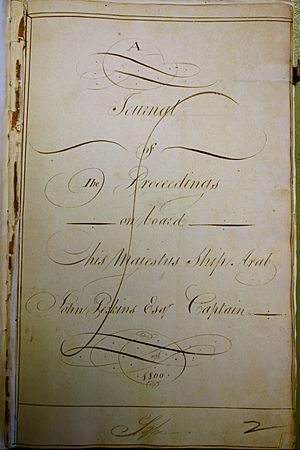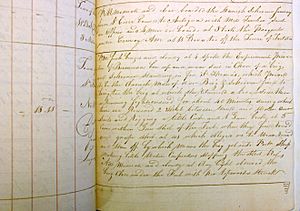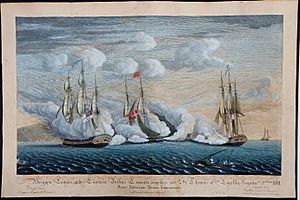HMS Arab (1798) facts for kids

|
|
Quick facts for kids History |
|
|---|---|
| Name | Brave |
| Owner | Benoit Boucard (part-owner) |
| Builder | Nantes, France |
| Launched | c.June 1797 |
| Captured | 24 April 1798 |
| Name | HMS Arab |
| Acquired | 1798 by purchase |
| Commissioned | 1798 |
| Fate | Sold on 20 September 1810 |
| Name | Arab |
| Owner |
|
| Acquired | 1810 by purchase |
| Fate | Sank June 1824 |
| General characteristics | |
| Class and type | 22-gun sixth rate post ship |
| Tons burthen | 489 or 500, or 505 48⁄94 (bm) |
| Length |
|
| Beam | 32 ft 8+1⁄2 in (9.970 m), or 32 ft 6 in (9.91 m) |
| Depth of hold | 14 ft 3 in (4.34 m) |
| Sail plan | Full-rigged ship |
| Complement |
|
| Armament |
|
| Notes | Two decks and three masts |
HMS Arab was a 22-gun warship of the Royal Navy. It was originally a French privateer ship named Brave. The British captured Brave in 1798. The ship served during the French Revolutionary and Napoleonic Wars until it was sold in 1810.
During its 12 years with the Royal Navy, Arab sailed to different parts of the world. It was involved in two important international events. One happened with the Danes, and another with the Americans. The ship also helped capture the islands of Sint Eustatius and Saba. Under different captains, it also captured many enemy ships, known as "prizes."
After the Royal Navy sold Arab in 1810, it became a whaling ship. It sailed on six complete whaling trips. The ship was lost in 1824 during its seventh trip, but all its crew members were saved.
Contents
The Ship's French Beginning and Capture
Brave was built in Nantes, France, around June 1797. It was a privateer, which means it was a privately owned ship allowed to attack enemy ships during wartime. It had a crew of 160 men.
On April 24, 1798, a British warship, Phoenix, captured Brave near Cape Clear Island. Brave had 18 guns and was built to carry 22. It fought back against the British, and some of its crew were killed or wounded before it surrendered. Phoenix had no injuries.
The British captain described Brave as a "very fine ship" that was "coppered" (meaning its bottom was covered in copper to protect it) and "sailed exceedingly fast." Brave had 50 British prisoners on board, which showed it had captured several British ships before being caught itself.
After its capture, Brave was taken to Plymouth, England. It was renamed HMS Arab and prepared for service in the Royal Navy. Workers added new decks to the ship. In December 1798, Commander Peter Spicer became its first captain.
Early Voyages and Challenges
In January 1799, Captain Thomas Bladen Capel took command of Arab. He sailed the ship to Jamaica in the West Indies. In July, Arab fought three Spanish warships near Havana. Three of Arab's crew were lost, but the Spanish ships eventually left.
During this time, there was a serious outbreak of yellow fever on board. Ten crew members, including the ship's carpenter, died from the illness. The ship's doctor kept detailed notes about the symptoms and treatments.
Arab also stopped and inspected other ships. For example, it detained an American ship called Porcupine that was carrying wine and other goods. Later, in October, lightning struck Arab off Cape Canaveral, killing three men and damaging the ship. Another yellow fever outbreak hit the ship in Jamaica, and 12 more crew members died.
Captain Perkins and the Danish Incident

Captain John Perkins took command in January 1801. He was sometimes called "Jack Punch."
In early 1801, there were rumors of trouble between Britain and a group of countries called the Second League of Armed Neutrality. On March 1, Captain Perkins received orders to stop all Danish, Swedish, and Russian ships.
Two days later, Arab and a British privateer ship called Experiment met two Danish ships. These were the brig Lougen and the schooner Den Aarvaagne. According to Danish reports, Arab fired at Lougen without warning. Lougen fought back. Experiment tried to capture Aarvaagne, but the schooner escaped.
Experiment then joined Arab in attacking Lougen. The two British ships surrounded the Danish ship. During the fight, a shot from Lougen hit Arab and caused its anchor to come loose. This made it hard for Arab to move. Captain Jessen of Lougen used this chance to sail his ship to safety near the shore batteries of St Thomas.
The Danish government honored Captain Jessen for his bravery. After repairing his ship, Captain Perkins captured many Danish and other foreign vessels in the area.
Capturing Islands
Between March and April 1801, Arab was part of a British force that captured several islands. These included St. Bartholomew, St. Martin, St. Thomas, and St. Croix. The British took many supplies and goods from these islands.
On April 16, 1801, Captain Perkins, with Arab and another captured ship, led an attack on the islands of Sint Eustatius and Saba. They captured the French soldiers there, along with many cannons and barrels of gunpowder. Sint Eustatius had been a very rich island in the Dutch West Indies.
Captain Robert Fanshawe took command of Arab in 1802. The ship returned to Plymouth for repairs. After a short break, it was put back into service when the war with France started again.
Napoleonic Wars Service
Lord Cochrane's Command
Arab was back in service in October 1803 under Captain Lord Cochrane. Cochrane later wrote that he thought Arab was a slow ship, like a "haystack." Under his command, Arab accidentally crashed into two other Royal Navy ships.
Despite his concerns about the ship, Cochrane still managed to stop and board an American merchant ship. This caused an international problem. Because of this, Arab and Cochrane were sent to protect fishing boats far away in the North Sea. Cochrane was very unhappy about this assignment, calling it "naval exile."
Captain Maxwell and a Brave Crew
Captain Keith Maxwell took over Arab in 1805. He sailed the ship to join a British fleet near Boulogne, France. On July 18, the British ships saw a French fleet sailing along the coast. Arab and other British ships chased them.
As Arab got closer to shore, the water became very shallow. Still, the British managed to force some French ships to run aground. However, the French shore batteries fired heavily, forcing the British ships to pull back. Arab had seven crew members wounded and suffered a lot of damage.
During this fight, a shell from a French shore battery hit Arab's main mast and fell onto the gun deck. A brave sailor named Clorento tried to stop the shell. Then, Edward Mansell and two other sailors helped him. Together, they managed to throw the shell into the sea, where it exploded safely. Captain Maxwell wrote to a special fund, telling them about the heroism of these men. The fund gave money to Mansell and the other sailors for their bravery.
In December, Arab was off the coast of West Africa. It later returned to the West Indies. During this time, Lieutenant Edward Dix temporarily took command. Two days after he joined, yellow fever broke out again. Most of the crew got sick, and 33 men died. Captain Maxwell then returned to command.
The Ship is Sold
The Royal Navy decided to stop using Arab. It was placed in storage at Woolwich. The Navy then sold the ship at Deptford on September 20, 1810.
Life as a Whaling Ship
After being sold by the Navy, Arab became a whaling ship. It was owned by Daniel Bennett.
Arab made six complete trips to hunt whales and seals between 1813 and 1824.
- On its first trip for Bennett, Arab sailed to the South Seas on September 22, 1813. It visited the Desolation Islands and returned to London in June 1815.
- The ship sailed again for the South Seas in June 1815 and returned in May 1816 with many barrels of oil and seal skins.
- For its next three trips, Captain George Barclay was the master. The ship left London in July 1816 and returned in March 1817.
- It left again in June 1817 and returned in March 1818 with 600 barrels of oil.
- On its fifth trip, Arab left in June 1818 for South Georgia. It returned in May 1819 with oil and thousands of seal skins.
- For its sixth trip, Captain Allen was the master, and the ship went to Walvis Bay. It returned to London in October 1820.
The Final Voyage and Loss
Arab's seventh and final voyage began on April 9, 1821, under Captain Alexander Sinclair. The ship sailed to New Zealand.
By June 11, 1824, Arab was in trouble. It was sinking with nine feet of water in its hold. Luckily, it met another ship called Ocean. Ocean was able to rescue all 36 crew members from Arab before Arab sank with its cargo of 300 tons of whale oil. Ocean then sailed to Saint Helena for repairs and supplies before reaching London in July 1824.


